Even better, though, is the way they ignite the imagination. I can’t visit a hut without imagining the adventurous spirits that have walked there before me, the stories shared around their fireplaces, and the amazing tales of survival they’ve made possible.
There are around 200 huts scattered throughout Australia’s alpine regions. Though some of them are much newer (like Craig’s Hut), others date back as far as the 1860’s.
For over 150 years, they’ve given shelter to cattlemen and women, gold miners, foresters, hydro-workers, fishermen, miners, skiers, and bushwalkers. Unquestionably, they’re an icon of European Australia.
Unlike in other countries where huts are setup for people to sleep in, most of Australia’s alpine huts are provided for emergency shelter only, but they are traditionally left stocked with matches and a small amount of firewood and kindling. Some hikers even leave behind emergency food rations. Relying on them is discouraged because hikers may arrive to find them full or even damaged by severe weather.
I’ve chosen 10 of my favourites for your viewing pleasure. Scroll down to read a bit about them and feel free to suggest yours in the comments below. I’ve received quite a lot of comments since I initially published this article and I have added a few more huts in recent times. However, please note that I’ve only published those that I can find a useable photo of. If you have a quality photo to contribute of a hut not featured here, please let me know.
Protecting the high-country huts
Although most of the huts are offered some level of protection by their inclusion within national parks (and some are even heritage listed), it’s organisations like the Kosciuszko Huts Association, Victorian High Country Huts Association and the Foundation for National Parks and Wildlife who we can really thank for what remains of this slice of Australia’s history.
These organisations have been campaigning since their inception for the protection of the high country huts, and are responsible for helping fund much of the maintenance, rebuilding and restoration work you can see when you visit the huts today.
What can you do to help? Volunteering with these organisations is a good start. Volunteers can get right in and get their hands dirty by joining the various working bees that happen at the huts. It’s not easy work but those who’ve tried it say it’s extremely rewarding.
Don’t have the time or the skills to get involved at that level? Maybe you can donate some money to the cause instead, either through the organisations above or by donating or shopping with Australian homewares and clothing brand, Pony Rider. For about the next 12 months, Pony Rider are aiming to contribute around $20,000 towards restoring the high-country huts, starting with Bullocks Hut in Kosciuszko National Park. Apart from a campaign encouraging customers to visit the huts (which in itself helps protect them) and to donate directly, they’re contributing a small percentage of sales from their National Project line (which includes some gorgeous beanies and blankets). They also chucked in $10,000 of their own to kick-start the program.
Craig’s Hut, Mount Stirling (VIC)

Image credit: “Craigs Hut” by jaydaley, on flickr
Okay, so maybe you don’t consider a hut built 35 years ago to be ‘historic’, but the original Craig’s Hut was built as a cattle drovers hut for the 1982 movie, The Man from Snowy River. Although I don’t actually remember the movie that well (I was probably under 10 the last time I watched it), nobody can deny that it’s a classic Australian movie.
The current Craigs Hut is actually its third incarnation, first re-built in 1993 after years of neglect and harsh alpine weather, and then again in 2006 after being burned down in a bushfire. The hut now has a tin roof, more easily maintainable than the original with its bark roof.
Check out this video for some more info…
Can I hike there?
Craig’s Hut is accessible by 4WD tracks, but there are also a couple of options for hiking there, one being the 3 kilometre / 2 hour return hike from the Circuit Road Picnic Area which, from what I hear, is as close as you can get to Craig’s Hut without a 4WD (see “Craig’s Hut Walk” in DSE’s Mount Stirling Forest Notes for more info). Another longer option is the hike from Telephone Box Junction, but the best information I can find about that is over on Andrew Bishop’s Trails and Tracks blog. You’re going to need a good topographic map.
Bradley & O’brien’s Hut, Kosciuszko National Park (NSW)
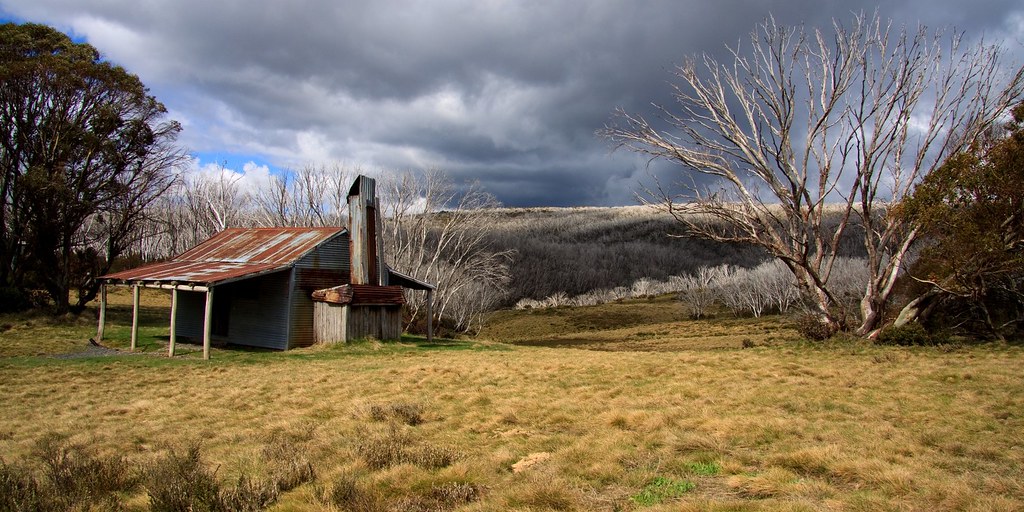
Image credit: “Orange Hawkweed Program, Kosciuszko National Park” by Office of Environment & Heritage, on flickr
Two graziers by the names of Pat O’Brien and Jack Bradley arranged for this hut to be built in the summer of 1952. Both men jointly held the snow lease for the area surrounding the hut, so it provided shelter for them and their labourers until 1958 when grazing was thankfully prohibited.
Can I hike there?
Bradley & O’Brien’s Hut is situated on the Cabramurra – Khancoban road between Tumut Ponds and Tooma Dam, so you certainly won’t need to hike to get there. While you’re visiting, though, it’s worth checking out the multitude of day and multi-day hiking options in the park. I haven’t done any hiking in Kosciuszko myself, so I’d suggest hitting up the Bushwalk Australia forum for suggestions.
Gooandra Hut, Kosciuszko National Park (NSW)

Image credit: “Goonandra Hut Built 1913 A.D.” by JB Maybury, on flickr
Miners initially built a small hut here in the 1860’s. However, the only part of this left standing now is part of the chimney which can be seen about 20 metres from the existing hut. This is one of the oldest structures in Kosciuszko National Park.
It wasn’t until 1913 that Gooandra Hut was built by a sheep grazier, who continued to use the old mining hut as his kitchen and also built a woolshed and several other structures nearby (the ruins of which can also still be found). Gooandra Hut was restored in the 1990’s but is still very similar to its original construction.
Can I hike there?
Gooandra Hut is accessible via a 9.4-kilometre fire trail which makes for okay walking, but much better snowshoeing. See this Trails in Kosciuszko guide for more details.
Kitchen Hut – Cradle Mountain National Park (TAS)

Image credit: “Kitchen Hut, Cradle Mountain National Park” by Luke Zeme, on flickr
By the early 1900’s, guided trips were already being led on what is now known as the Overland Track, and it was regularly being hiked without guidance by hunters, miners, and recreational walkers alike. By the 1930’s community concern was growing about them getting lost, so this is probably what led to the construction of Kitchen Hut by the Connell family in 1939. Arguably the most attractive of the Overland Track huts, its name was taken from a nearby creek, which has been known as The Kitchen because it was regularly used as a place to stop and boil a billy before or after the ascent of Cradle Mountain.
Can I hike there?
You sure can. Kitchen hut is on Tasmania’s Overland Track. Surely everyone’s heard of it but, for those who don’t know, it’s a 65-kilometre trail that usually takes about 5-6 days to complete. After the hike, you’ll want a couple of low key relaxing days in the Cradle Mountain region.
Vallejo Gantner Hut, Alpine National Park (VIC)

Image credit: “Vallejo Ganter Hut” by ccdoh1, on flickr
This is one of few memorial huts in Australia, built in 1971 in memory of Vallejo Gantner, an adventurous young fellow who died in the mountains in 1962, aged only 19. It’s one of only two A-frame huts in Victoria, and one of only three architecturally designed huts. It’s strategically located as an overnight stop between Mt. Howitt and the Crosscut Saw for walkers on the Australian Alps Walking Track, and features spectacular views of Crosscut Saw.
Can I hike there?
As mentioned, Vallejo Gantner Hut is on the Australian Alpine Walking Trail (AAWT), between Mt. Howitt
and the Crosscut Saw. It’s also accessible from the 14 kilometre / 5 hour (return) Mount Howitt Walk (see Parks Victoria’s Park Note).
Four Mile Hut, Kosciuszko National Park (NSW)
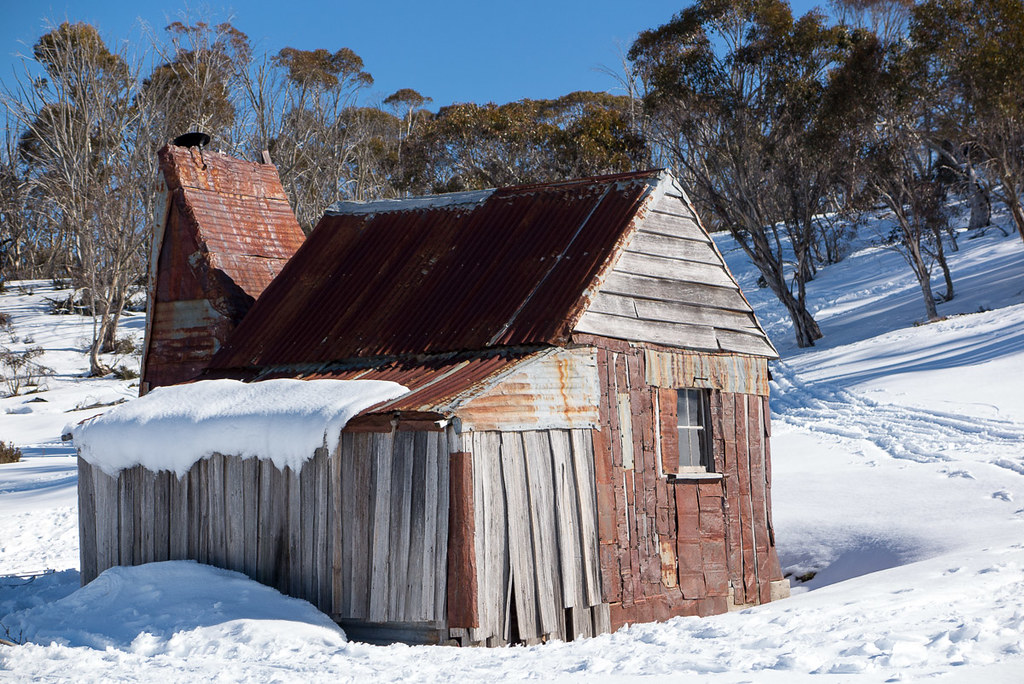
Image credit: “Four Mile Hut” by Phil Hart, on flickr
Originally used as a mining residence for gold panners, Four Mile Hut was built by Robert Hughes in 1937. It was built from scrap materials left lying around from mines in the area, mostly from the Elaine Mine which Hughes himself managed from 1926 to 1936.
Can I hike there?
Yep, the 10 kilometre / 4 hour (return) Four Mile Hut Walk starts from Mount Selwyn Resort. See the NSW Parks & Wildlife Service website for more information.
Cope Hut, Alpine National Park (VIC)
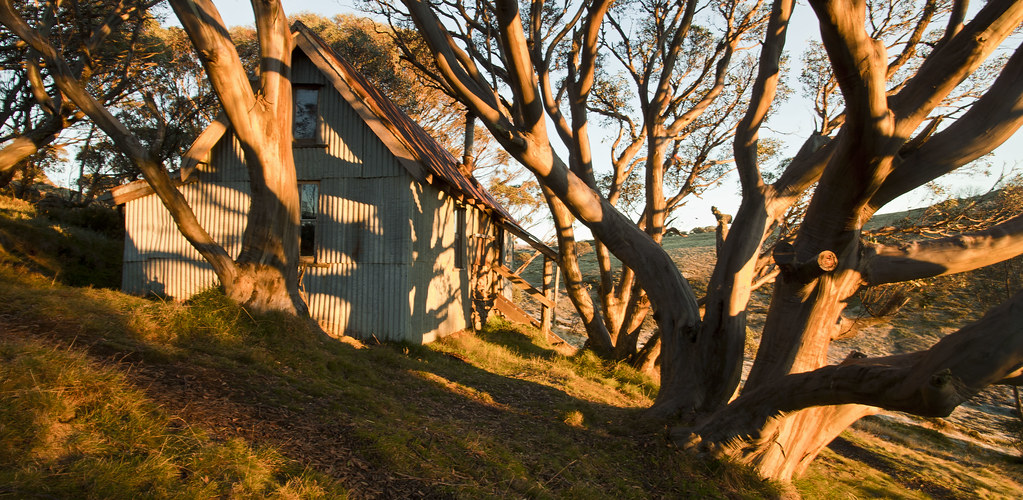
Image credit: “Cope’s Hut” by matt brand, on flickr
Another of the rare architect-designed huts in Australia, Cope Hut was built by the Ski Club of Victoria in 1929 after skiing in Victoria experienced a surge in popularity during the 1920’s. It was so large and comfortable that it was dubbed ‘The Menzies of the high plains’. It continues to be used by skiers and bushwalkers to this day.
Can I hike there?
There are a few options for hiking to Cope Hut. Parks Victoria have a Park Note that gives a couple of ideas, starting with one option that’s only 500 metres / 15 minutes (return). A good topographic map of the area will give you some longer ideas.
Seaman’s Hut, Kosciuszko National Park (NSW)
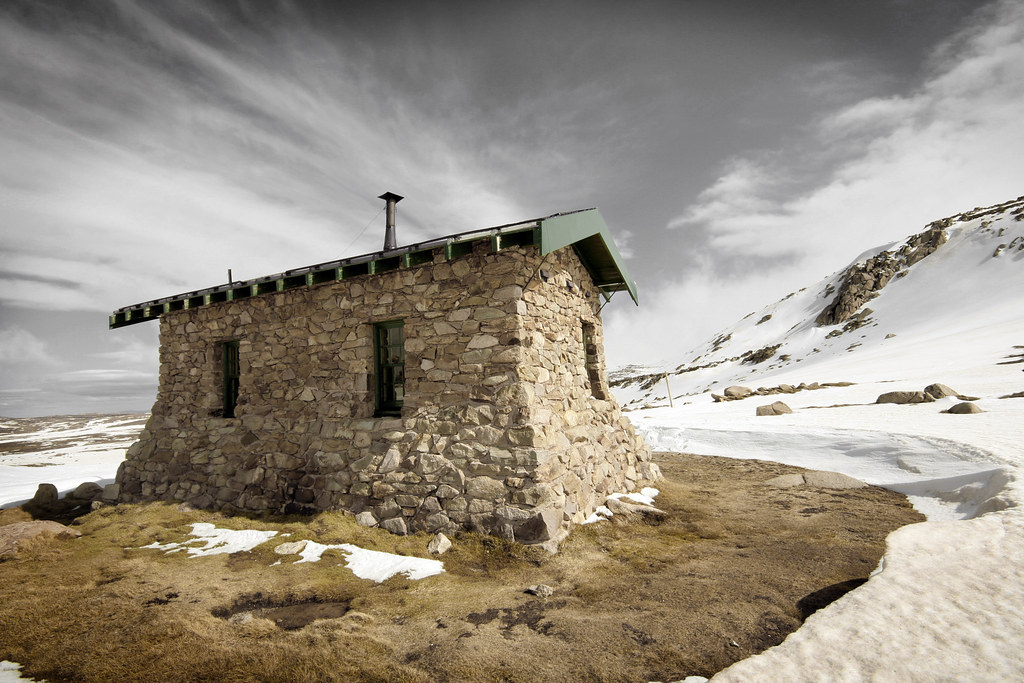
Image credit: “Seaman’s Hut” by Owen Thomas, on flickr
This stone hut was built in 1929 as a memorial to another young man, Laurie Seaman, who died of exposure while skiing at the location of the hut. His parents paid for the hut to be built, in the hope that future visitors to the park would use it as shelter to avoid a similar tragedy. Laurie Seaman’s skiing companion, Evan Hayes, wasn’t found until months after the tragedy when warmer weather returned and allowed the search to recommence.
Can I hike there?
Seaman’s Hut can be accessed on foot from Thredbo, Charlotte Pass or Guthega. It’s only a 1.5-kilometre detour off the Mount Kosciuszko Summit Walk. I’d still advise bringing along a good topographic map that covers the area’s walking tracks.
Wallace Hut, Alpine National Park (VIC)

Image credit: “Snowgum Grove” by matt brand, on flickr
One of the oldest Victorian high country huts, Wallace Hut was built in 1889 by three Irish brothers, Arthur, William and Stewart Wallace, who held a grazing lease in the area. It provided shelter to the cattlemen working there for many years, before being handed over to the State Electricity Commission in the 1920’s, and then the Boy Scout Association in the 1940’s.
Can I hike there?
Wallace Hut is another one with a few options. A couple of them are covered in one of Parks Victoria’s Park Notes (the shortest is 1.5 kilometres / 45 minutes return), but you’d be best checking out a good topographic map before you make your decision.
Pendergast Hut, Alpine National Park (VIC)

Image credit: “Pendergast Hut” by Joel Bramley, on flickr
Strangely, I haven’t been able to find out anything about Pendergast Hut. While I remember admiring it and its incredible views on my last visit to Mount Buller, I don’t recall seeing an information board, and even the Mount Buller Ski Resort website makes no mention of it. I had to include it, though, because I love this photo.
If you know anything about this one, please let me know in the comments below. If I find out anything elsewhere, I’ll come back and fill in the blanks.
Can I hike there?
Pendergast Hut is perched right beside the carpark near the Mount Buller summit, so you don’t need to hike there. However, there are a whole bunch of other hiking trails nearby to explore, some of which depart from this very carpark. Check out the Walking Trail Map from the Mount Buller website for details. Little Buller is a favourite of mine (but I haven’t written about it yet).
Cleve Cole Hut, Alpine National Park (VIC)

Not too far from the summit of Mount Bogong (Victoria’s highest summit), Cleve Cole Hut is spectacularly located just below the treeline and surrounded by twisted snow gums at an altitude of around 1,760 metres.
Cleve Cole was a Victorian skiing pioneer who died doing what he loved after becoming trapped on Bogong in the winter of 1936. Like so many of the huts in the Alpine high country, it was constructed to help prevent further tragic deaths by providing shelter for outdoor adventurers.
Can I hike there?
Cleve Cole Hut is a popular camping spot for hikers taking on overnight hikes on Mount Bogong. It can be visited as part of a day hike but with ample camping space around the hut and plentiful drinking water available from nearby streams, I recommend spending a night there.
Fry’s Hut, Alpine National Park (VIC)
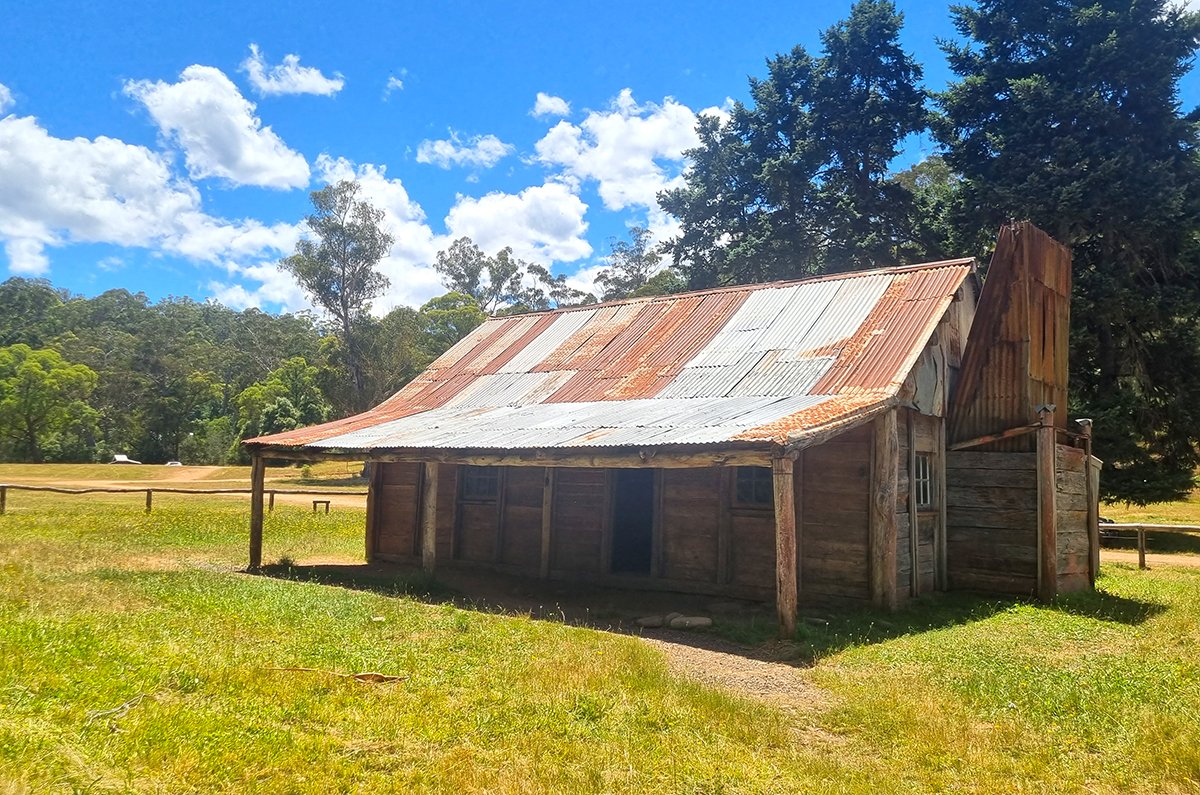
Deep in the Howqua Valley, at the 4WD-accessible Fry’s Flat Campsite, lies one of the more unique alpine huts.
In the 1930s, a bushman by the name of Fred Fry built a home here by the side of the Howqua River. Fred lived in the split timber hut alone for many years, prospecting and taking other work from government agencies and fishermen. This interesting life much later became the basis of the 1950 novel, ‘The Far Country’, by Neville Shute.
Can I hike there?
Fry’s Hut can be accessed from the 2WD-accessible Sheepyard Flat Campsite via the Howqua Hills Historic Walk. Sheepyard Flat to Fry’s Hut will be about a 1.5-hour return hike.
Have you got any better huts in mind? Got anything at all to add? If you have any stories, updates or corrections, please let us know by commenting below.






Hmm.
I’ve hiked to many huts, usually in winter with snow shoes.
A historic hut you have not mentioned is Spargos hut.
We should chat.
Seaman’s Hut is beside the old Kosciusko Road between Charlotte’s Pass and the summit of Mt Kosciuszko. Walking access in summer is possible from Charlotte’s Pass where the road is closed via the easy gradient of the old road and across the two forks of the head of the Snowy River.
Cheers for the extra info, Sve!
I visited 53 huts on my Xmas trip to the high country, love em!
That’s a lotta huts, Ray! Nice work. There’s a lot to love about them. I don’t blame you!
Cheers
Neil
Hi is there any huts that u can drive to near water not far out of Talbingo?
Hi Kayla, there’s a good map here – https://www.google.com/maps/d/viewer?mid=1wwu078JFDFPisEGLSk1s7XE_J_QIFYaP&femb=1
Best
Neil
A reasonable list (though ‘Hike’ still annoys me beyond my pain-level..) but 1 and 10 have no place here – both are modern pastiches and deserve to burn down. And most are a short walk from a road or 4wd track – you need to get out a bit more! Tin Mine and Mawsons Huts in Kossie, Westons Hut in Alpine. Widen it to what us old-timers can remember staying in, I’d nominate the Summit hut on Bogong!
I’m always saying I need to get out more, Mick. Thanks for your suggestions. If I get a few more I might even do a part 2!
Cheers
Neil
I don’t believe the hut on Buller is Pendergast hut, the original hut referred to by Harry Stephenson in the book Cattleman and Huts of the High Plains was over on the Limestone Creek north of Omeo. The Pendergast family were from around that district.
Hey Martin, so are you saying the hut in the photo above isn’t Pendergast? Because it says “Pendergast Hut” right there on the sign.
Cheers
Neil
What about an Alpine yurt? 🙂 https://www.facebook.com/Aussiehikes/photos/a.1380095562302918.1073741828.1376303759348765/1539959606316512/?type=3&theater
Yurts are always a good idea, Nadia. Always. 🙂
Great read. My favourite is Oldfields Hut in northern kozzy.
I would add Pretty Plain, one of the few log cabins and Wheelers Hut http://khuts.org/index.php/the-huts/kosciuszko-national-park/760-wheelers-hut, a beautiful slab hut. Pretty Plain http://khuts.org/index.php/the-huts/kosciuszko-national-park/680-pretty-plain-hut didn’t survive the 2002 fire but was rebuilt. Both are near the Tooma reservoir in Kosciusko NP.
Hey Ken,
Thanks for the tips! Will have to check them out.
Cheers
Neil
Love the article. The huts are one of my favorite things about the high country. I think my favorite hut is Cleve Cole hut which is on the way to the summit of Mount Bogong.
Thanks Adriaan! Mine too. I love Bogong so can’t believe I didn’t think to include Cleve Cole!
Cheers
Neil